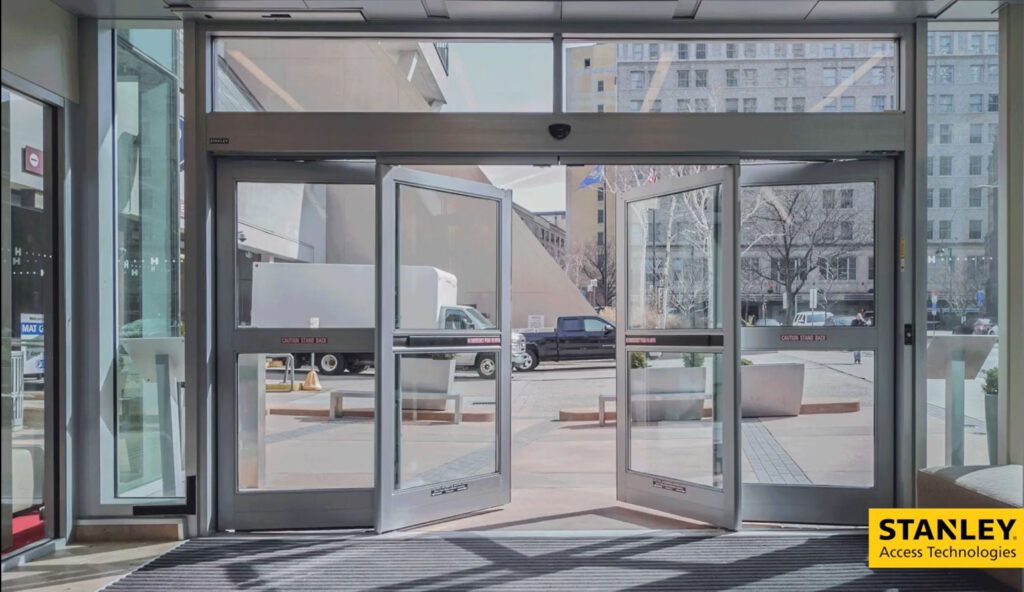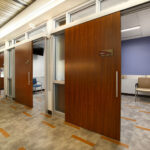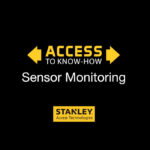 As I mentioned in a past post, STANLEY Access Technologies is now part of the Allegion family of brands. Since the inception of iDigHardware, I have focused mostly on the requirements for swinging doors, and I have not dedicated a lot of posts to sliding doors. However, there are several important code requirements that are specific to automatic sliding doors. I will be tackling these topics in the coming weeks, beginning with today’s Quick Question:
As I mentioned in a past post, STANLEY Access Technologies is now part of the Allegion family of brands. Since the inception of iDigHardware, I have focused mostly on the requirements for swinging doors, and I have not dedicated a lot of posts to sliding doors. However, there are several important code requirements that are specific to automatic sliding doors. I will be tackling these topics in the coming weeks, beginning with today’s Quick Question:
Under what circumstances does an automatic sliding door require the break out / break away feature, allowing the sliding door to swing in the direction of egress during an emergency?
Both sets of model codes require power operated pedestrian doors to comply with ANSI/BHMA A156.10, Standard for Power Operated Pedestrian Doors. This standard includes requirements for automatic swinging, sliding, and folding doors that are not considered low-energy automatic doors, and defines the following terms:
- Break Away Device: A safety device other than an exit device that permits egress under emergency conditions (also called emergency release).
- Break Out: The process of activating a break away device causing the door or panel to swing in the direction of egress.
Basically, automatic doors with this feature will swing open in the direction of egress if needed for emergency evacuation – automatic sliding or folding doors temporarily become manually-operated swinging doors. The BHMA standard and the model codes limit the opening force for the break out feature to 50 lbf, applied 1 inch from the leading edge of the lock stile.
As I have said many times before, the answer to a code question often depends on which code or codes have been adopted in the building’s jurisdiction, because the requirements of the various codes may differ. While researching the answer to this question, I think I found one of those differences between the I-Codes and the NFPA codes, on the topic of automatic sliding doors.
In the 2021 edition of NFPA 101 – Life Safety Code, Section 7.2.1.9 addresses the requirements for automatic doors, and Paragraph 7.2.1.9.1.5 states: The door assembly shall be designed and installed so that, when a force is applied to the door leaf on the egress side, the door leaf shall be capable of swinging from any position to provide full use of the required width of the opening in which it is installed. The requirement for the door to swing open when a force is applied to the egress side is what would mandate the break out / break away feature for automatic sliding or folding doors. Section 7.2.1.9.1.7 exempts automatic sliding doors from the “swing-out feature” when the door serves an occupant load of less than 50 people, as long as the door can be slid open manually within the force limitations stated in the code. Signage is required, stating “IN EMERGENCY, SLIDE TO OPEN.”
In the 2021 edition of the International Building Code (IBC), the requirements for automatic doors are found in Section 1010.3.2 – Power-Operated Doors. Similar to NFPA 101, this section states (in part): The door shall be capable of opening from any position to the full width of the opening in which such door is installed when a force is applied to the door on the side from which egress is made. Again, this is what mandates the break out or break away feature, but the IBC does not include an exception similar to NFPA 101 that would exempt automatic sliding doors serving an area with a certain occupant load.
The closest thing to an exception that I can find in the IBC is in Section 1010.1.2; this section defines the types of doors that are allowed in a means of egress. While side-hinged swinging doors, pivoted doors, or balanced doors are required for most locations, there are 9 exceptions listed in this section – circumstances where other types of doors are permitted. Exception 7 allows power-operated doors in accordance with Section 1010.3.2. Exception 9 permits manually operated horizontal sliding doors to be part of a means of egress from spaces (other than Group H – High Hazard) with an occupant load of 10 people or less. An AHJ MIGHT interpret this to mean that an automatic sliding door would not require the break out / break away feature if the automatic sliding door is serving an occupant load of 10 people or less, but this is a fairly rare application for an automatic slider.
Other than this potential interpretation, I don’t see anything in the IBC that would allow the break out / break away feature to be omitted on an automatic sliding door in a means of egress. Do you? Please share your experience in the comments.
~~~
The video below demonstrates full breakout and partial breakout on the STANLEY Access Technologies Dura-Glide 2000 and 3000 automatic sliding doors.
What other questions do you have about the code requirements that apply to automatic sliding doors? Leave them in the comments!
You need to login or register to bookmark/favorite this content.










You know I love signs !!!!!
Should there be a code requirement, to be placed on the door, both sides.
No storage, obstructions, etc with in ???? Feet on any side of door??!
Not sure how many feet that should be.?
Glad you should ask. I do a lot of design work requiring the doors to be operated by credentials. Seems like a simple task, no? Doors that are deactivated by a switch are usually accompanied by a hook bolt deadlock which must engage the strike in a way that does not allow forced separation of the doors and break away from the exterior side. If you want to card control this door (i.e. valid card enables the exterior motion detector during locked periods). Let’s not forget the motion detector on the interior side, which is startlingly easy to circumvent with spray air or a coat hanger with a flag on the end. So now you need to shunt the inside motion detector, but you still need a request to exit so you place a push button on the inside that enables the motion detector AND serves as the REX to the access control system. As far as I know, push bars that latch into the top track should do the trick. But I have not seen many of these.
Thanks for sharing your insight, Jim! If it was easy, it would be called “easyware”! 😀
– Lori